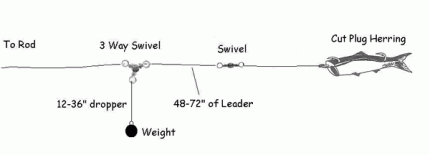
Tidewater (or estuary) fisheries offer small boat owners access to ocean bright fish, often in high densities. These fisheries can be very popular as demonstrated by the extremely popular “Buoy 10” fishery at the mouth of the Columbia River. This is not a place to go for solitude, peace and quiet. But it is a place where fishing can be fast and furious. Other well known tidewater locations include Willapa Bay and Grays Harbor. However, any river entering the Pacific Ocean or Puget Sound has the potential to offer some exceptional salmon fishing in tidal influenced areas.
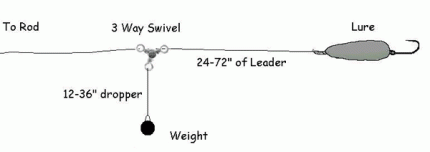
There are three major types of tidewater fishing, and a handful of other methods. The majority of anglers will be trolling, plunking, or fishing under a bobber or float.
Trolling
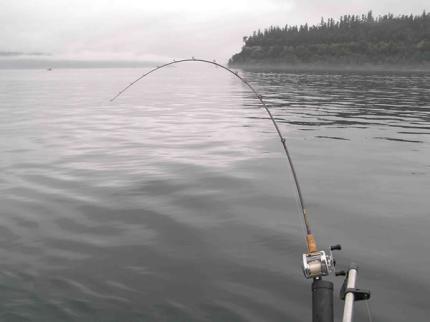
Trolling is probably the most popular method of fishing tidewater. Trolling consists of fishing out of a constantly moving boat. Trollers use weights, divers, or downriggers to achieve a desired depth to present their bait or lures. The standard drift fishing rod equipped
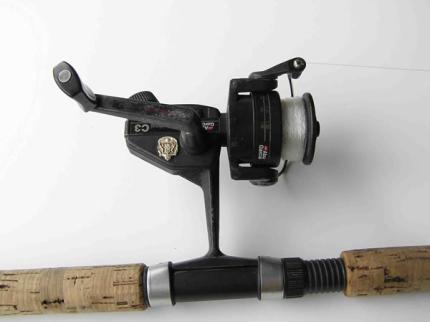
with 20-25 pound line can be used for river or bay salmon trolling. An 8 ½ or 9 foot rod rated for 15-30 pound line, and either a bait casting reel or a spinning reel works well for trolling (Photos 1 and 2). Use at least 20-25 pound line for tidewater trolling, as these fish usually fight extremely hard. Trolling setups are usually comprised of a three-way swivel at the end of the mainline, a 12-36” dropper line and weight off the center of the three way swivel, and a 4-8’ foot leader with twin hooks and a cut plug herring or lure. You can also rig a sliding weight set up instead of a three-way swivel.
Instead of a cutplug herring, you can also troll spinners (Photo 3), plugs (Photo 4), kwikfish, or bait harnesses (Photo 5).
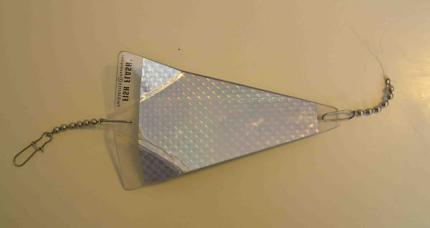
Weights are usually 2-8 ounces depending on the speed of the current and boat. The dropper line used for the weight is usually lighter than the mainline so that the dropper breaks before the mainline if the weight becomes snagged. Many anglers now use an in-line rotating flasher along with their herring (Photo 6).
Rig the in-line flasher between the three-way swivel and the herring, ensuring that the distance from the swivel to the flasher is longer than the distance of the weight dropper line.
When fishing deeper waters at Buoy 10, use a diver (Photo 7) or downrigger (Photo 8) to get your gear down. When its crowded, be sure to keep your lines as close to your boat as possible so you don’t get tangled with the lines from nearby boats. If someone on your boat hooks a fish, be sure to move your boat away from the others to fight it, and if you’re next to a boat that hooks a fish, move away so they can land it.
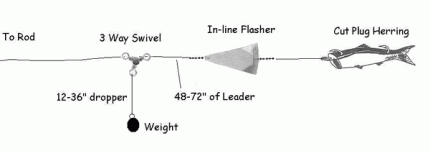
Fish at the depth your fish finder shows fish for fall chinook and coho. Bottom is always a good bet for chinook. For coho, you may not even need weight for your lures and can sometimes find fish quite close to the surface.
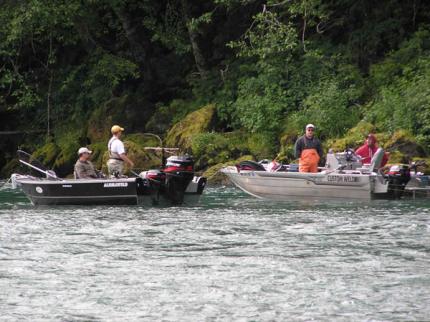
Plunking
Plunking employs a similar setup to drift fishing, except that the gear is cast into a likely holding area or migratory path, and allowed to anchor in one spot (Photo 9). The gear is then left alone until a fish strikes, or you decide to change gear. Active lures such as winged bobbers, spoon, spinners, or kwikfish are often used when plunking in current. Plunking can be done from shore or an anchored boat.
A very popular lure on the Columbia River is a kwikfish wrapped with a small filet of sardine or other fish (Photo 10). Use an 8½ to 9 foot, extra heavy rod. Your mainline should be 40-60 pound monofilament or spectra. At the end of your mainline, slip your line through the end of a swivel or slider, add 4 beads, and then tie to a swivel.
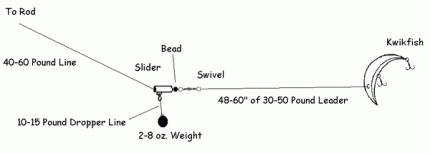
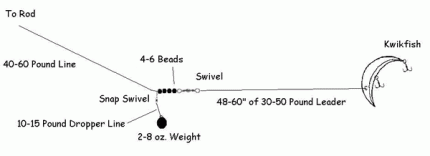
Tie 4-6 feet of 40-60 pound monofilament leader to the other end of the swivel and then directly to the duo-lock snap on the kwikfish. Tie an 18-30” piece of 15 pound leader to the slider (or swivel that you ran the mainline through) and attach 1-8 ounces of lead. Most salmon anglers use sizes K13 to K16. Use the larger sizes in slow water and the smaller sizes in faster water.
Be sure to tune your kwikfish so that it dives straight down when you pull it upstream through the water. If it dives to the left, turn the screw eye clockwise. If it dives to the right, turn the screw eye counter-clockwise. Back the kwikfish downstream until the weight is firmly settled in place on the bottom and the kwikfish is still wobbling from side to side. Put your rod in a rod holder and don’t try to set the hook when a fish first hits. Let the fish pull the rod down to water level at least 3 times before trying to reel it in.
Thin bladed spoons can be plunked on lighter, or medium action, rods in smaller rivers or slower water (Photo 11 and Photo 12). The size of the spoon is matched to the depth and current speed where it will be fishing. They can be fished with weight and a dropper if necessary, or you can just “flatline” them in shallow water, that is, fish them without any added weight. Thin bladed spoons should be let out behind your boat until you reach the desired location, generally in 4-5 feet of water on the upstream side of a riffle. These spoons work best on lighter lines, around 15 pound test, and if you are fishing without weight, they work best when the line has a belly in it between the water and the tip of rod. Spoons are very effective on pink and coho salmon. Use smaller spoons (½ – 1½”) in pink, white, red, cerise, or combinations for pink salmon. For coho use medium size spoons (2 - 3”) with silver or brass blades that can also be painted. Popular colors are chartreuse, fluorescent pink, and fluorescent orange.
Where in a river to set your gear is a critical element of plunking. On larger rivers, try to set up on an inside curve where any fish migrating up that side have are forced around the point. In smaller rivers, look for tail-outs just upstream of riffles. These are areas that fish will rest in after swimming through the riffles. At low flows in small rivers, stay towards the main current, and look for areas where the current starts to slack up a bit. In larger rivers, or small rivers at high flows, work the edges where the current isn’t too fast. Remember that upstream migrating salmon are looking for the easiest route up the river that offers enough cover that they feel safe from predators. That cover may be deep water, logs, boulders, a bubble curtain, or even the white water in a riffle.
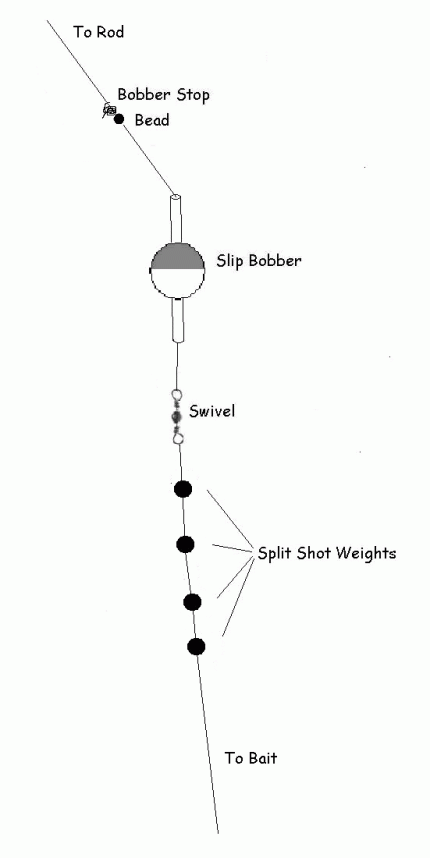
Bobber or Float Fishing
Bobber or float fishing is a very popular method in British Columbia and Oregon, but isn’t seen often in Washington, except during steelhead season. Bobbers are usually used in situations where water is very slow moving or even stagnant, such as in a big eddy or tidewater at slack tide. However, you can fish under a bobber in moving water. Rods of 10-12’ are not uncommon for float fishing. Spectra lines are desirable because they don’t stretch and they float. To rig for float fishing, use a sliding float (Photo 13), a swivel, some weight to pull the line through the float, and a 12-24” leader to a bait or lure. A “bobber stop” and small bead are used to set the float at the depth you wish to fish. The bobber stop can be reeled through the rod guides if necessary for easier casting. Bobber stops can be purchased pre-tied, or you can tie your own with 15-30# Dacron using a uni-knot. Very early in the morning, you might find fish suspended off the bottom and will want to set your bobber stop so that your gear is at the depth you think fish are suspended at. Once the sun hits the water, salmon tend to move to the bottom and you should adjust your bobber stop so that your bait or lure is within a foot of the bottom. Serious bobber anglers use a longer rod than drifters or trollers, and switch their mainline to a no-stretch Spectra based line.
When fishing in current, you will need to “mend” the line occasionally. Mending generally means lifting and/or flipping the line so that any belly is removed and the line is then in a straight line between the rod and bobber. The reason for mending the is to ensure a good hookset if the bobber goes down. If you have a big belly in the line, all you accomplish with the hookset is taking the belly out. Spectra based lines float and are therefore easier to mend, and their lack of stretch ensures that all of the hookset is transmitted to the bait or lure. Salmon eggs are the top choice for bait, although sand shrimp are very popular for chinook salmon. Some anglers like to fish both at the same time. Marabou jigs (Photo 14) can be used instead of bait and can be especially effective on pink salmon, or other salmon when the water is very low and clear.
Most of the time, a salmon will simply pull the entire bobber under water in one smooth motion. You need to set the hook hard with a big sweep of the rod when that happens to ensure a good hookset. Because your line runs to the bobber and then down, you don’t have a straight shot to the hooks. Therefore you need to pull enough to straighten the line out and move the hooks. Occasionally salmon will just mouth your bait without pulling the bobber under and it may simply quiver or dance, or even just stop. Experienced bobber anglers set the hook whenever something unusual happens. When fishing a bobber in tidewater, small fish such as pile perch, sculpins, or even smolts, can be frustrating because they may try to eat your bait. When these small fish are abundant, they will constantly cause your bobber to dance and quiver. But you must set the hook when it does this, because it may be a salmon. You might set the hook 20 times on these small fish, but on that 21st time, you’ll only get halfway back and be firmly into a nice chinook.
Be sure to keep an eye on your bobber when fishing this way. When the fishing is slow, its very easy to get distracted or lose interest and look away from your bobber. Invariably, when you turn back to find your bobber, you won’t see it anywhere. Just about the time you start to mutter to yourself “where did my bobber go?”, it will come floating back up after a fish has let it go.